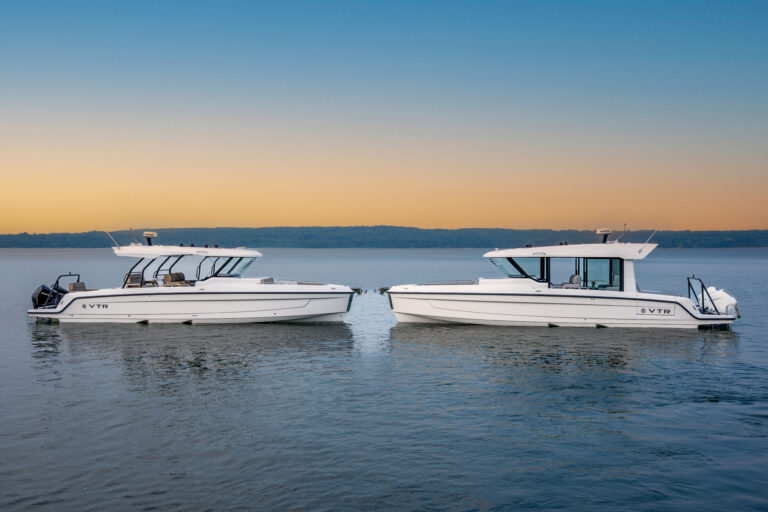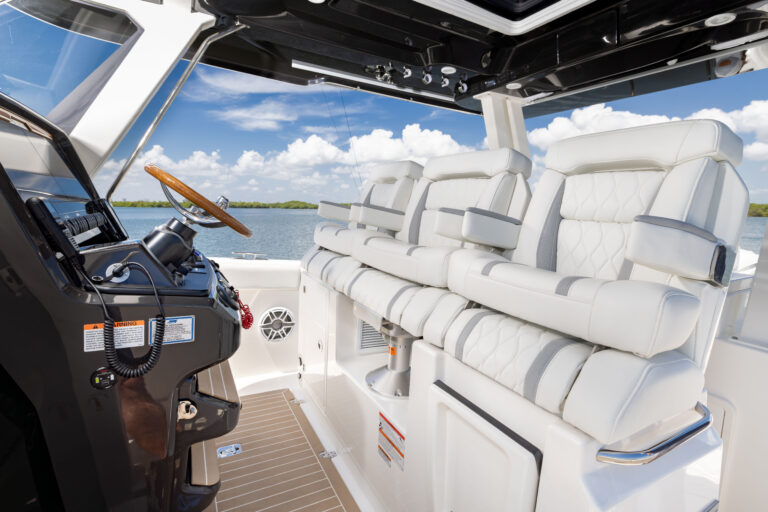
Late spring season is my favorite time of year. This is when I get to try out some of the new products that caught my attention at the winter shows. This year, some of the most interesting products I’ve come across include a propeller, a series of multifunction displays, a fuel filter with an NMEA 2000 water-in-fuel alarm and a small-boat stabilizer from Seakeeper.
Sharrow MX-1
This Sharrow design has the potential to revolutionize propellers. Sharrow says that its MX-1 wheel can increase efficiency by up to 15 percent. The company also says the prop will increase top speed, reduce vibration, improve handling and help boats plane at lower speeds.
According to Greg Sharrow, the founder of Sharrow Marine, the key to these improvements is avoiding tip vortices: circular disturbances in the water at the tip of a traditional propeller. These disturbances reduce efficiency and increase vibrations. Sharrow’s design eliminates tips, which reduces vortices. This design has the potential to replace nearly any conventional propeller, from those found on recreational boats to 1,000-foot ships. The MX-1
received the National Marine Manufacturers Association Innovation Award at the Miami International Boat Show for propulsion equipment and parts. It’s quite inspiring to see a rethinking of a design that’s been around for hundreds of years.
Furuno TimeZero Touch 3
Furuno’s new series of multifunction displays will be available in 12-, 16- and 19-inch sizes. The 12-inch version has hybrid controls with touchscreen and button/knob interfaces. The 16- and 19-inch versions are touchscreen only, but Furuno offers remotes.
One of this series’ biggest deals is what Furuno is calling the TZ Cloud ecosystem, which includes the new displays as well as the TZ iBoat mobile app, TZ Cloud web platform, and Nobeltec’s TimeZero Navigator and TimeZero Professional computer software. TZ Cloud allows waypoints, routes, photos and zones to be synchronized—quickly—among all TimeZero products.
Furuno also announced the debut of its DRS12A-NXT and DRS25A-NXT solid-state open-array radars. The DRS12A-NXT is a 100-watt radar with performance similar to a 12 kW magnetron array. The DRS25A-NXT is a 200-watt radar with performance roughly equivalent to a 25-kW magnetron. These radars are compatible with TZT2 and TZT3 multifunction displays.

Signal Filters Fuel Head
Signal Filters introduced a filter head that alerts boaters to the presence of water in fuel by raising a message on the NMEA 2000 network. Most systems with alerts use a sensor that connects to a bowl below the filter. The Signal Filters system has a metal rod that goes to the bottom of the filter to measure resistance. That rod makes contact with a sensor in the filter head. The filter head also contains the alarm and NMEA 2000 electronics. Signal Filters are a standard size. (If you find yourself in a pinch, you can buy a filter without the probe.) The filter head runs about $400 and has been tested to 180 gallons of fuel per hour without restriction.
Seakeeper 1
The Seakeeper 1 is the newest and smallest member of Seakeeper’s lineup. With a $15,000 list price and a target boat size of 23 to 29 feet length overall, the Seakeeper 1 should bring more comfortable boating to a wider audience.
Seakeeper redesigned several aspects of its stabilizer technology to make installation easier and less expensive. The Seakeeper 2 and 3 units could mount directly to the boat’s deck as long as the deck was glued to the boat’s stringer system. But the Seakeeper 1 has a reshaped flywheel enclosure so that it doesn’t hang below the unit’s frame. This means the Seakeeper 1 can be installed on the boat’s deck without cutting out the floor below it. The entire unit occupies about the same space as a 65-quart cooler, so it fits under leaning posts, inside of seating and in
many cockpits.
Continuing the theme of simplification, there’s a control panel on top of the Seakeeper 1 to manage the unit without a helm-mounted controller, though I suspect most installs will leverage Seakeeper’s integration capability with multifunction displays.
Like the Seakeeper 2 and 3, the Seakeeper 1 works with DC power, so it can use the alternator output of the boat’s engines. The Seakeeper 1 spins up to stabilizing speed in 21 minutes, and it takes 31 minutes to reach its full 9750 rpm speed. That’s a significant improvement from previous units. The braking system is also simplified, with a single-cylinder, hose-free unit to enable field replacement.
For information on other leading-edge systems and equipment, see the list of innovation award winners from the Miami International Boat Show at panbo.com.
This article originally appeared in the June 2020 issue.










